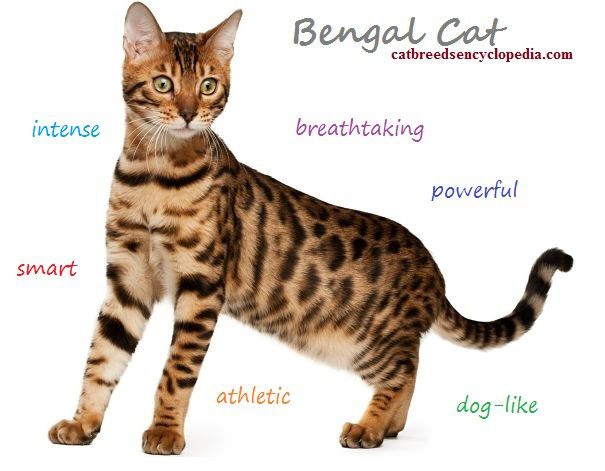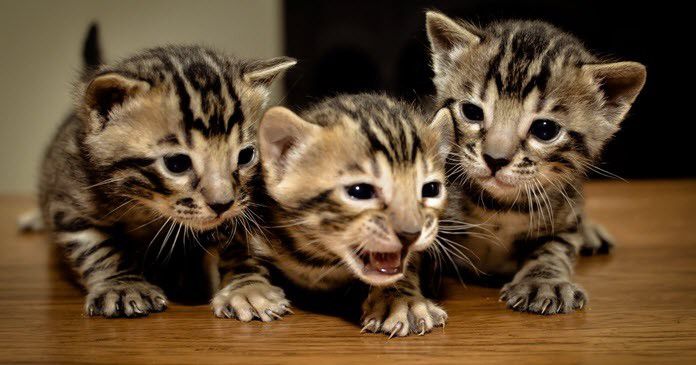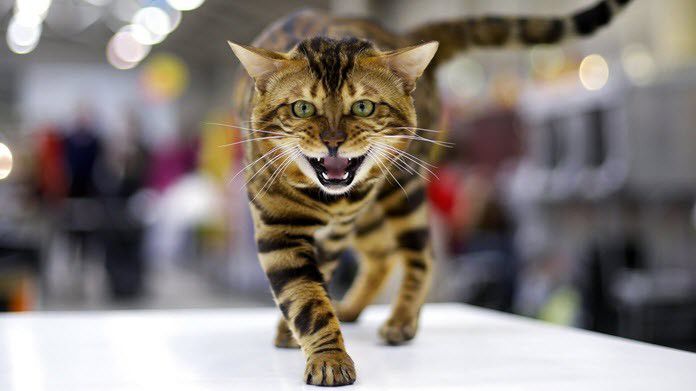Human beings, as we all know, can influence their surroundings, deforming and transforming them as they wish.
One day people discovered the leopard and tried to tame its wild side, and thus our star, the Bengal cat, was born. This cat has a wonderful personality and such a wild beauty that we could spend hours contemplating it.
Bengal cats, scientifically known as Prionailurus Bengalensis, are created by the selective breeding of two cats, the Asian Leopard cat (or Bengal cat) and domestic cats.
This cat originated in 1963 in the United States. Both cats were crossed to make way for this relatively new breed. The TICA (The International Cat Association) approved the breed in 1986.
Today, it’s one of the most displayed breeds in competitions celebrated by this association. Nevertheless, there are still some international organizations that don’t accept the breed, meaning that these cats are only allowed to participate in certain shows.
Characteristics of the Bengal cat
Classified as a short-haired cat, the main feature of the Bengal cat, and the reason why this breed was created, is its striped markings. It has short, thick and silky hair.
Its color varies from ivory to orange, while its spots, called rosettes, range from cinnamon to black, although the basic color is the brown spotted tabby.

Bengal cats are large felines that weigh approximately 5-8 kg (males) and 3.5 kg (females.)
The head of these cats is round and broad, slightly wedge-shaped and a bit smaller in proportion to the rest of its body. They also have strong jaws.
The nose is wide, vast and orange with a thin, black line. The eyes are almond-shaped and are of a greenish-yellow color. Snow leopards are the only Bengal cats to have blue eyes.
Bengal cats have prominent, high cheekbones. Its ears range from small to medium and also feature rounded tips.

The neck is thick and muscular and relatively larger in proportion to its head and relatively longer in proportion to its body. It has a high, black-tipped, medium length tail.
The body of Bengal cats is sturdy and muscular with thick bones. It’s equipped with long and healthy limbs, making it look athletic and slender. The hind legs are slightly longer than the front legs. Both the abdomen and pads are spotted.
The ‘Art’ of Crossbreeding Cats
As we mentioned before, this breed comes from crossbreeding a domestic cat with a wild cat, the Felis Bengalensis.
But why do people do this?
The answer is because they want a domestic cat that looks like a wild feline.

Many people attempted to cross several generations, achieving different results. The cats involved in the first crossings, the first generations (F1, F2, and F3), were considered the foundation cats. They start being considered Bengal cats in the fourth generation (F4).
Obviously, to get to this point, it was necessary to use the most friendly and affectionate kittens and cross breed them with domestic cats such as the Ocicat, Abyssinian, Bombay, British Shorthair and, above all, the Mau Egyptian, which has the least number of recessive genes in comparison with other breeds.
This is logical if we consider that we could have a Leopard cat whose most distant ancestor is the Bengal tiger in our home otherwise. We’d probably run at the first sign of aggression.

They’re breathtaking specimens created by man. Complaining and saying that the miracle of creation shouldn’t be a human trade does no good.
Thank goodness that the use of wild cats isn’t allowed for the creation of this breed nowadays.
Health of Bengal Cats
Because these cats are crossbreeds of two cats, what we call hybrids, they exhibit hybrid vigor, meaning that they have a greater resistance to many diseases than their parents.

Although unusual, they may suffer from emotional instability due to their wild genes. That’s why fourth generation Bengal cats are recommended because their genes of domestication are consolidated. You only have to make sure not to skip routine pet visits to keep them healthy.
Bengal Cat Behavior
Bengal cats are excellent swimmers that love water. This is a quality inherited from their wild ancestors, as well as being an exquisite climber.

They are very hyperactive and curious, very sociable, playful, intelligent and active.
They are very loving and get attached to the humans they live with, accompanying them throughout the house and waiting for them at the door when they return from work.
They can perfectly share space with other pets such as dogs, cats, and even ferrets. We have to be careful with birds and rodents.
If you’ve never lived with a cat before, perhaps this breed shouldn’t be your first option. This is mostly because they’re cats that need a lot of daily attention with games, activities and various interactions. This translates into an energetic cat capable of mischief. This cat is advised for active people and homes with other pets.
Their great loyalty and intelligence allow for them to be trained to respond to individual orders similar to how a dog would. Some emit strange sounds, similar to banks.
Their life expectancy is approximately 13 years.
Caring for a Bengal cat
The Bengal cat, like most short-haired cats, doesn’t require a lot of attention to keep them in perfect condition. They are self-sufficient cats that clean themselves.

The only thing to keep in mind regarding grooming is that they produce more ear wax than other breeds, so you must clean their ears regularly.
The most important aspect is to keep their immunizations up to date and provide them a healthy and varied diet with high-quality food.
Some experts warn of the danger of this super cat breed that some breeders are exploiting by trying to bring the wild side of cats into our homes, as this could be dangerous.
However, since only fourth generation cats are allowed, Bengal cats tend to be well-socialized cats that are used to human contact and coexist perfectly with other pets.
Apart from the Bengal cat, other super cat breeds exist, such as the Savannah. Here is an article we wrote about them in case you’re interested: Savannah, The Supercat.
Price of Bengal cats
Bengal cats have many different prices since not all kittens have the same characteristics and are of the same quality. The cats are classified according to whether they’re going to be “used” as pets or are intended for exhibitions or breeding.
On the average, a Bengal cat can have a price between $450 to $800. A cat that is a greater quality can cost from between $1,100 and $1,500. A cat that is show quality can cost from between $1,500 to $2,500.
For instance, there are cats that range from $1,500 to up to $2,500. There are kittens that go in price from $450 to $1,000, depending on the quality. A breeder might sell their kittens for between $1,200 and $4,000. Bengal cats over two years of age can cost between $75 and $300. A Bengal cat cost can range from $650 to $2,000.

How to choose the best Bengal cat breeder: It’ll be easy for you to separate the real professionals from those who just want to fill their pockets with money following a few tips:
- On-site vs. Online. No matter how much they ensure you that it’s a quality kitten, buying your cat online without seeing it beforehand is the equivalent of a pig in a poke. Visit the breeder if you can and analyze its facilities, how well the kittens are cared for, etc. This is perhaps the most important tip.
- Knowledge vs. Ignorance. Unwritten rule: those who sell cats of a certain breed should be experts in said breed. If the breeder isn’t capable of providing information, you shouldn’t trust them. The breeder probably crossed Bengal cats with God knows what.
- Cheap Pedigree vs. Expensive Pedigree. If you want the pedigree of your cat and they assure you that getting it is very expensive, the best thing you can do is leave without the cat. It’s a lie that getting the pedigree is expensive, the only thing that is expensive is that the breeder has to have everything to be able to give it to you.
- Documented vs. Undocumented. They have to give you all of the kitten’s necessary documentation. This includes the veterinary health certificate, veterinary inspections, etc. The kitten should also be dewormed, and its immunizations should be up to date.
- References vs. Proceeding Blindly. The internet has all the information you need to figure out if a breeder is good or is selling sick kittens. Read people’s opinions. I’m sure they’ll help you decide.
Also remember that the kitten mustn’t be separated from its mother before its 12 weeks old. It needs to be with its mom and complete its socialization process.
In conclusion, the Bengal cat is obtained thanks to human experiments with the intention of having leopards at home that wouldn’t devour them. It’s an amazing, wild-looking, sweet and loving cat.
These cats are whims many people will fall in love with, although they know that adopting a kitten is always better than buying one. Remember that natural things are twice as good.


4 Comments
I have been given a bengal kitten that was found on the side of the road with no mother cat. The kitten is only about 5-6 weeks old. How do I help this kitten survive and potty train? Kitten is eating special kitten wet food that vet recommended but doesn’t show understanding of a litter box.
Having a Bengal vs. regular domestic house cat is like night and day. They are so different; they’re more like a dog, and quite physically different too. My Bengal was sleeker than my other cats and heavier because she was pure muscle. They’re so agile too, and can jump really high and twist all around. You have to get the feather toy that has a stick with an elastic string with feathers at the end. Mine loved her feather toy so much, she would drop it at your feet if she wanted to play, just like a dog. And Bengals are so smart and good at figuring out how to do stuff. Our Bengal even learned how to open doors with door knobs. She would jump up and twist the knob with her paws coming down, and lean in to open the door. And putting things up high for Bengals does not work. Her food bag, which weighed about 2 lbs, we used to keep up on top of the fridge, but she would just jump up there and knock the food bag down. We’d hear a big crash and some rustling noises, and you hear something dragging on the floor, and then the door would creak open and she’d be standing there next to her food bag, and let out a huge meow, like she was saying, “Feed me now!”… Needless to say, we had modify her food storage situation due to this… And our Bengal would go nuts anytime she heard water running because she wanted to play and bat the water with her paws. She also peed in the toilet (evidently this trait comes from their wild ancestors). And she was very loud! Ours was like our personal alarm clock with her constant loud meowing until you got up, and sometimes she would come jump on you with both her paws on your chest and meow right in your face. But she was also the sweetest cat ever and she never bit or scratched anybody, and although she was shy around strangers at first, she would always come around eventually, usually slowly making her entrance doing her tiger stalk walk to check out the scene first. But in no time she’d be playing and making friends with everyone. All I can say is, Bengals are some of the most amazing cats, but definitely not a good cat to own if you’re not able to devote a lot of time to them.
We have a Snow Leopard Bengal he is 6 years old and indoor. We took him from a family that paid him no attention and for the most part just kept him in the bedroom. We also have five male cats and one female cat now the bangle his name is Charlie he’s 6 years old and he’s very sweet he’s never like fit me or scratched me or anything like that but we’re having a hard time and I was like to get somebody else’s opinion that does have a Bengal cat we’ve never had one before like I said I wanted to get him out of his situation he was in he is very aggressive with our other cats and has literally gotten into fights with him so I feel really bad because one of our cats is 14 years old and she is totally stressed out and he already spent like half the day under the bed anyway because he’s older but now he seems to spend about 90% of the day under our bed so you can’t be around another one of our cats at this point so I’m just a little worried I thought about trying to find him another home my husband wants to keep him and try to you know I work with him a little more to see if we can get him acclimated with the other cat’s a little better I’m just not sure what to do so do you have any other cats besides the bangle and how old is your bangle thank you in advance.
My wife is wanting to get a cat and I told her that if we got one, we would have to get a Bengal kitten. Since then, my wife and I have been looking up characteristics about the car and the different things that it does. I think that it would be a good idea to get a crossbreed version of the cat. Like you mentioned, it is important to find a cat that has been bred with a calm house cat because that combination would be a very tame cat.